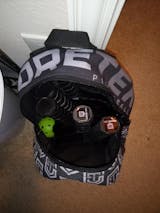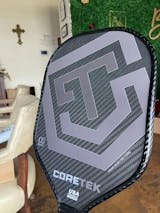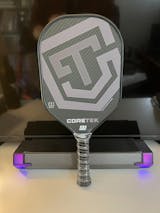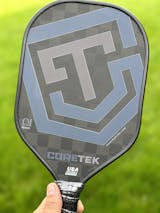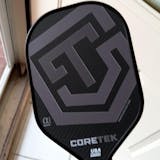Here at Coretek Pickleball, our DFW-based design lab is obsessed with a single question: what truly makes a paddle perform? In a market flooded with terms like "maximum grit" and "enhanced spin," we wanted to go deeper. We embarked on a comprehensive data science project to move beyond the hype and build a quantitative understanding of performance.
Our journey involved analyzing hundreds of paddles, building and discarding models, and ultimately creating a predictive engine that can estimate a paddle's spin potential with remarkable accuracy. This is the story of how we did it, and what we learned along the way.
The Two Pillars of Spin: Friction & Dwell Time
From a physics perspective, generating spin is a simple formula. You need two ingredients:
- Friction: The "bite" of the paddle surface that grabs the ball.
- Dwell Time: The duration the ball stays on the paddle face, allowing that friction to do its work.
Our challenge was to find measurable paddle features that act as proxies for these two concepts. A simple linear model looking at basic specs failed spectacularly, explaining only about 22% of the variance in spin. The relationships, we quickly learned, were far more complex.
"Our breakthrough came when we moved to advanced models like Gradient Boosting, which could understand the complex, non-linear interplay between a paddle's physical and dynamic properties."
The Key Ingredients: What Our Model Learned
After extensive modeling, our final model achieved an R-squared value of **0.87**, meaning it can explain over 87% of the variance in spin. It did this by identifying the true drivers of performance. Here are the most important features, ranked by their impact:
1. Grit Surface Type
This was, by far, the most important factor. The model learned that the manufacturing process of the surface is paramount. Paddles with a modern "Raw Texture/Peel Ply" surface consistently produced hundreds more RPM than those with a simple "Paint Grit" applied on top of a smooth face. This feature is the primary source of Friction.
2. Core Thickness
Thickness is our best proxy for Dwell Time. The model found that thicker cores (e.g., 16mm) allow the ball to dwell into the paddle face for a fraction of a second longer. This extra contact time gives the high-friction surface more opportunity to apply rotational force to the ball, significantly boosting spin. This is not a function of elasticity but dampening and energy distribution throughout the paddle face. We were able to build a highly efficient model for predicting spin without any knowledge of face stiffness!
3. Engineered Dynamic Features
This is where the deep science comes in. The model's accuracy was unlocked by two key features we engineered from base measurements:
- Mass Distribution Index (`Swingweight / Weight`): This ratio quantifies how "head-heavy" a paddle is. A higher index means more mass is concentrated at the tip, which helps the paddle maintain momentum through the "brushing" motion of a spin shot.
- Pseudo-Density (`Weight / Thickness`): This ratio gives us a sense of the paddle's material density. The model found that denser, more solid-feeling paddles were more effective at translating swing energy into spin.
Try It Yourself: The Spin Potential Calculator
To bring our findings to life, we've created a calculator based on the logic of our final, most accurate model. Input the key specs of a paddle below to see its estimated spin potential. This is the same type of tool our engineers here in DFW use to accelerate our design process.
Spin Potential Calculator
Predict paddle spin based on our best model.
Needed for key engineered features.
Conclusion
This journey into the data behind paddle performance has been incredibly revealing. It confirms that engineering a great paddle is a true balancing act between competing physical properties. By understanding these relationships quantitatively, we can move past guesswork and build better paddles, faster. This commitment to data-driven innovation is at the heart of everything we do here at Coretek Pickleball.
We have already integrated power-aware spin into a prototype model to investigate the relationship between spin and power. We found a negative correlation between spin and power, but until we have a better power R^2 we are happy with the progress we have made on our power-naive model of spin.





